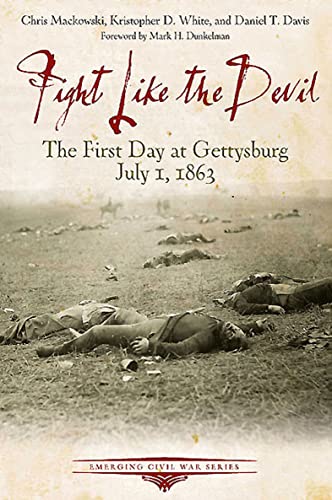BG John Buford thought that he would be the first to engage the ANV as it approached Gettysburg. He was wrong. He wasn’t even the first cavalry to do so.
In response to reports that Lee had crossed the Potomac, MG Couch who commanded the Department of the Susquehanna out of the state capital of Harrisburg, sent troops that way. Under the command of COL Wm. Jennings, 743 men of the 26th Pennsylvania Emergency Militia arrived by train. They were joined by a squadron of 45 Adam’s County Cavalrymen under CPT Rob’t Bell.
Together they moved west to find Lee’s army. It was 26 June 1863. Cresting Whistler’s Ridge just outside Chambersburg, they spotted the vanguard of Ewell’s Division. Recognizing that his tiny force was hopelessly outgunned, Jennings ordered an immediate return to Gettysburg. Before they could cautiously withdraw, he was set upon by elements of Ewell’s cavalry. While trying to evade them, Jennings’ men turned north and followed the railroad tracks knowing that those would lead them back to Harrisburg. The 17th Virginia Cavalry pursued them for a few mile before breaking contact. The Union threat had been driven off.
Two days later Jennings and his beleaguered men were home.
Meanwhile, Bell’s cavalry made for Gettysburg. They in turn were chased by the 35th Virginia known as the White Comanches. Bell’s men entered the city just ahead of their pursuers. They scattered down lanes and alleyways. The rebels saw no value in chasing them further.
The first engagement of the Battle of Gettysburg was over!
MG Jubal Early was incensed that his men would be challenged in this way. He had entered Gettysburg on the heels of the cavalry. He demanded to see the mayor only to be told that the mayor had fled the city as had many of its residents. Among these were a large number of Free Blacks (estimated at about 200 men, women and children) who knew that capture meant a return to servitude. As per the SOP, Early provided the citizenry with a ‘shopping list’ of demands like 7000 pounds of bacon and 600 lb. of coffee. [the ANV subsisted on chicory as a coffee substitute but sought real coffee wherever they went.] Having hidden away all stores of such items, the citizens resisted and offered a cash payment instead. Early’s men couldn’t eat cash so he sent them from house to house. Although this was technically against Lee’s “no looting” order, they gathered up horses, chickens an alcohol, but no bacon nor sugar. They also found no shoes!
Disappointed with the haul, he moved on towards Hanover and York.
Buford had yet to arrive at Gettysburg.
========================
The above information comes from Chris Mackowski’s book Fight like the Devil. In it he might also have planted the seeds of a new myth for the battle. He has BG Buford telling his senior staff on the evening before their ambush that “the enemy must know the importance of this position, and will strain every nerve to secure it.” Nowhere have I read anything that suggests that Lee had any appreciation what so ever of what lay ahead. For him, Gettysburg was just a convenient gathering point for his Army in reaction to the approach of the AoP.

Seemingly, it wasn’t until he scaled the ladder to the seminary copula that he noted the presence of the hills that the Union wanted to occupy. That’s when he sent his famous “if practicable” order to MG Ewell.
Mackowski also describes and aborted encounter between the armies on 30 June. As Pettigrew’s brigade of Heth’s division was approaching the city that morning, they crested Wistler’s Ridge, just west of Wiloughby Creek, and spotted mounted men. Mindful of Lee’s order of to bring on a major engagement, he withdraws. But when he reports his sighting to AP Hill, it is dismissed a ‘mere militia’.
For me at least, Mackowski introduces a new fact. He relates the origin of the name of the town of Cashtown. According to him, it was based on the fact that the local inn founded in 1797 did a cash only business. Now in the 19th century I’m not sure what else might be used except perhaps barter.] That inn still operates in the same place in the 21st century! It advertises “healthy neighborhood and pure mountain air”.
I’m sure that it is not a new discovery but he goes on to attribute the first shot of the battle to one LT Marcellus Jones of the 8th Illinois Cavalry. https://en.wikipedia.org/wiki/Marcellus_Jones Near Whistler’s home stands a First Shot memorial marker. He goes on to name the first two casualties of the battle later that morning. Apparently, Jones’ shot went astray. Confederate PVT C Worley and Union PVT John Weaver were both wounded in the leg during an early morning exchange of shots by the respective pickets. It is recorded that Weaver died weeks later following amputation. Worley’s fate was unrecorded.
The title of his book apparently is derived from another quote attributed to Buford. When LTG Reynolds approached the Seminary and asked about the disposition of the battle, Buford is said to have replied; “The devil’s to pay.”
Mackowski enumerates that Buford had over 12,000 infantry in his First Union Corps and 22,000 more in the Eleventh and Third corps that followed.
